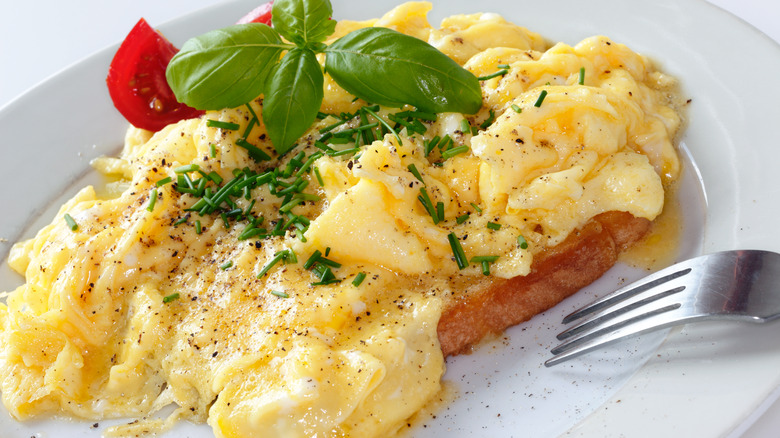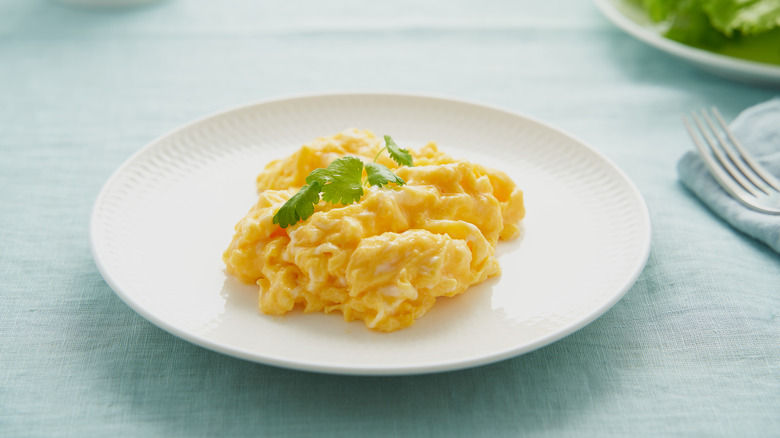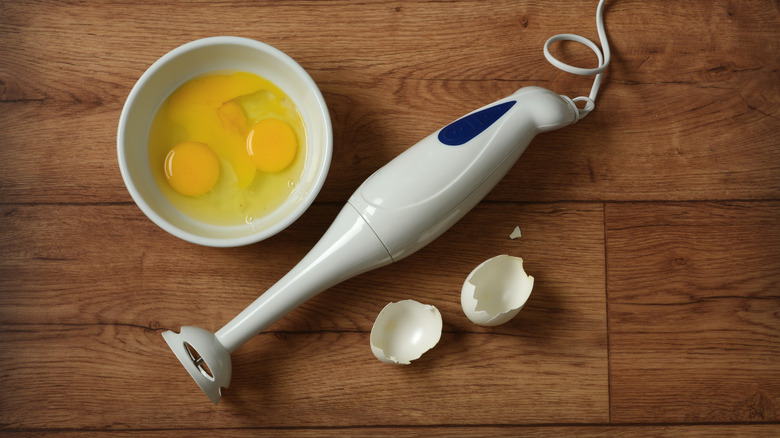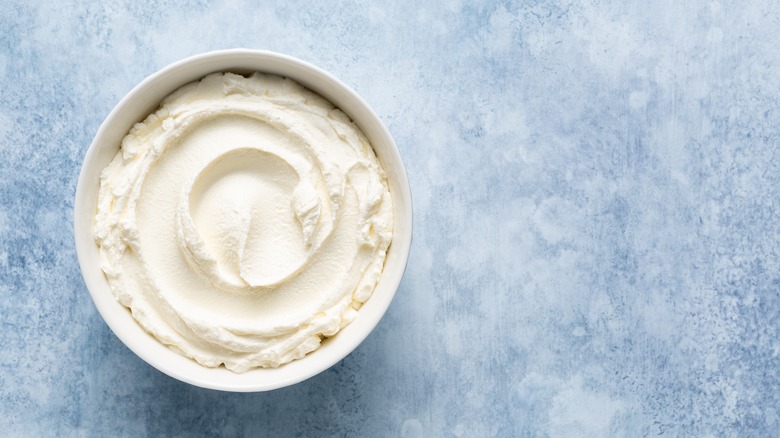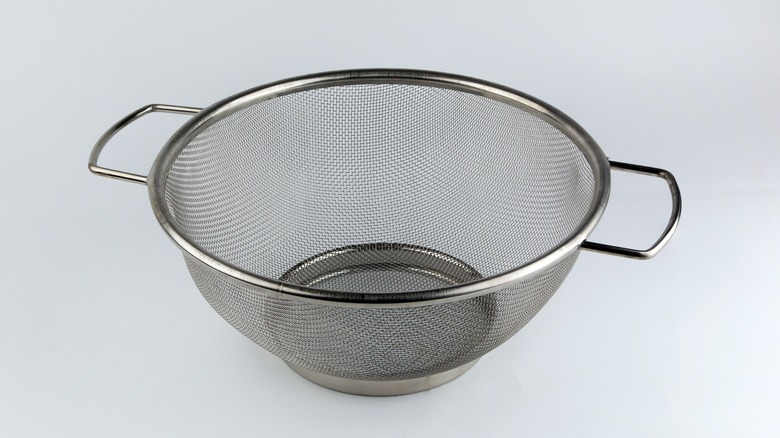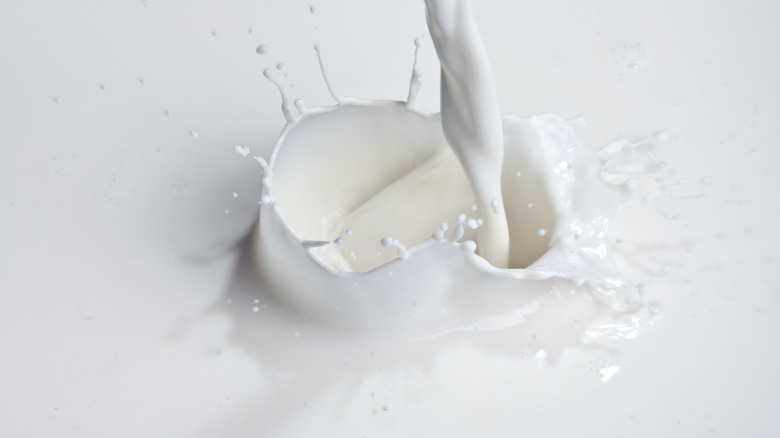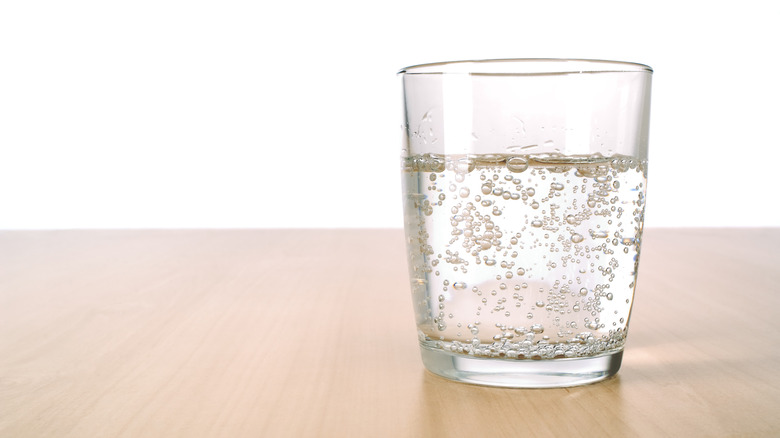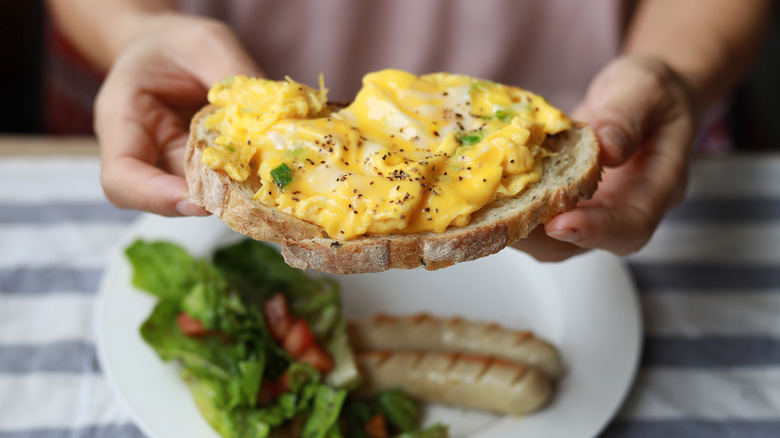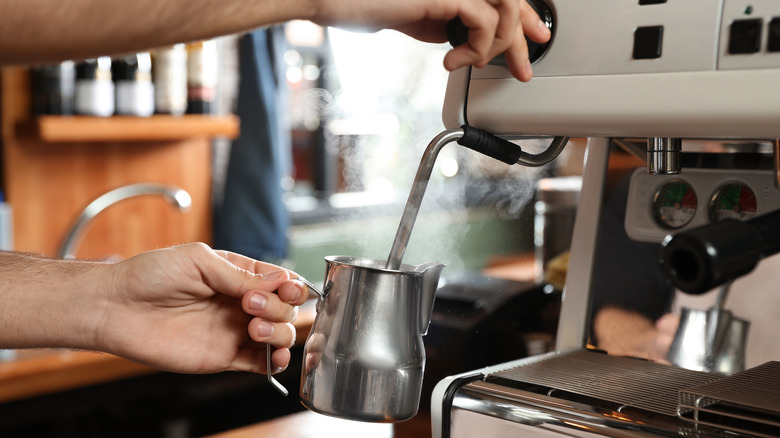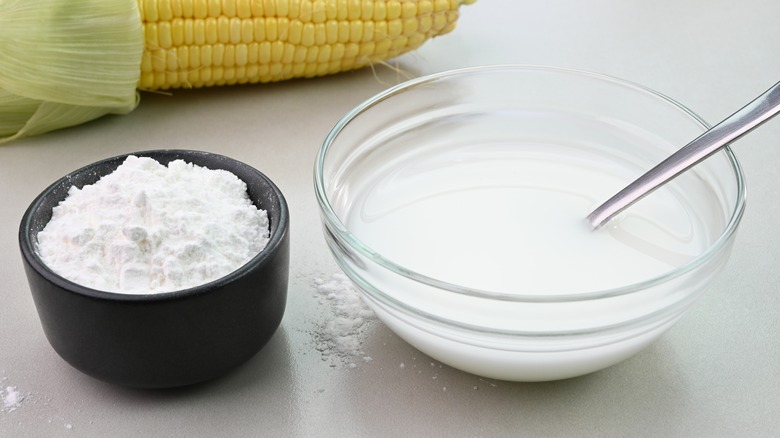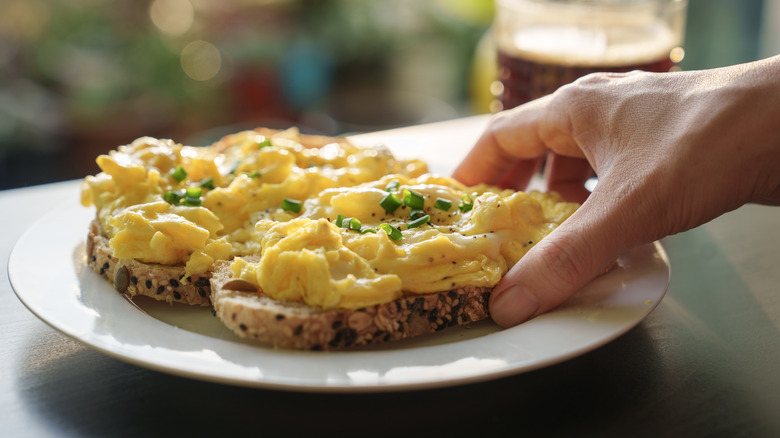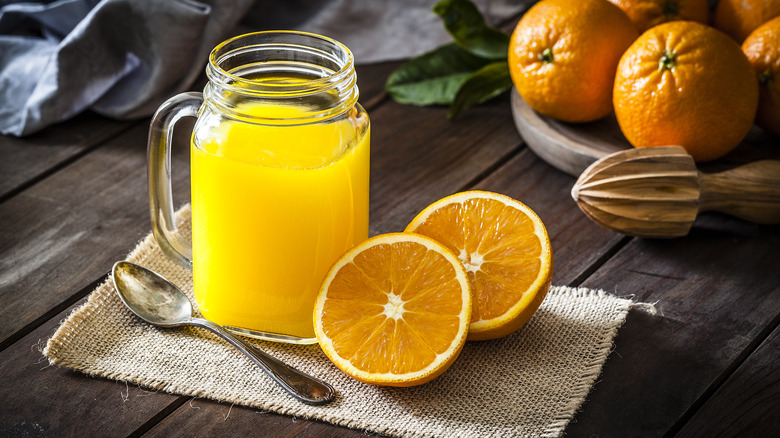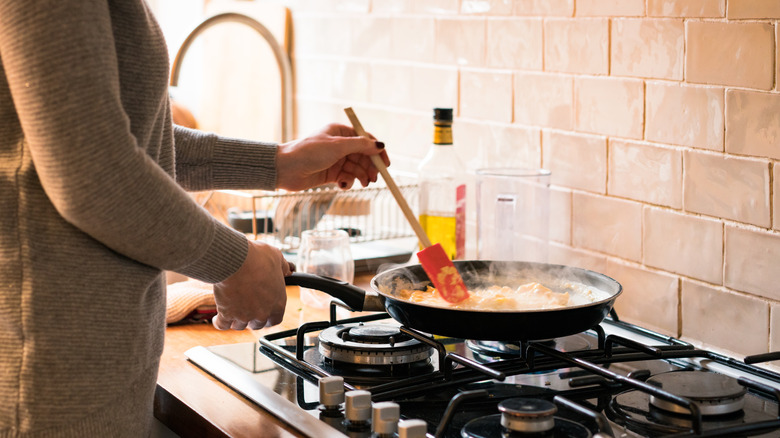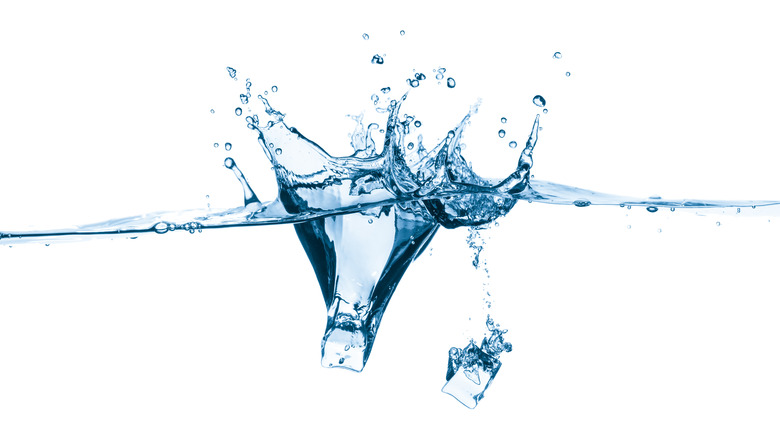14 Scrambled Egg Hacks That Will Change Your Life
There are fewer dishes that are more versatile than scrambled eggs. This meal can be cooked and eaten at any time of the day and is protein-rich, satisfying, and delicious. But it's only going to taste good if it's made right, and scrambled eggs are surprisingly easy to mess up. Overcooking them even slightly can cause them to become dry and rubbery, and using too high a heat can result in them scorching. Whisking them too early, meanwhile, can prompt them to end up flat and airless, and seasoning them too soon can leave them sloppy.
To add to this, scrambled eggs are also one of those dishes that we tend to fall into habits with. As a staple meal that almost anyone can make, it's easy to stick with the method we learned the first time we made it and not deviate from it. So, how do we avoid some of the most common mistakes out there while simultaneously learning new methods to make next-level scrambled eggs? Luckily, all it takes are a few simple hacks to spruce up your eggs without any significant additional effort.
1. Save clean up time by cooking them in the microwave
Your microwave is useful for a lot of things, but we tend not to use it for eggs. There's a good reason for that: Eggs have an unfortunate gift for turning into bombs when microwaved, with a build-up of steam leading to an explosion. Luckily, though, this tends to only happen when the egg is still inside its shell or when the yolk is still formed and not properly incorporated with the white. When scrambled, eggs can not only be cooked safely in the microwave, but quickly, too.
"Microwave scrambled eggs won't taste too much different from stovetop ones, especially if you season them well," The Practical Kitchen founder Rebecca Eisenberg told Reader's Digest. All you have to do is beat them in a microwave-proof bowl, then add your seasonings and some extra liquid, — like milk or cream — to make them extra fluffy. Then, blast them in 30-second intervals, beating them lightly at the end of each cycle, until you have your desired consistency. It's a good idea to add a little extra fat into the mixture to replace the cooking fat used in a pan. Bear in mind that if you like your eggs especially soft, the microwave probably isn't the best method, as it can tend to produce firmer curds.
2. An immersion blender makes the eggs fluffier
The scrambling of scrambled eggs is, of course, a vital step. Scrambling not only mixes the eggs together and incorporates your seasonings or additional liquids, but it also gives your eggs additional air content. The small air bubbles that get into the eggs make them lighter and fluffier, and the more you have, the more pillowy your eggs will be.
If you want super-airy eggs, though, the answer might lie in your immersion blender. Immersion blenders scramble eggs rapidly, and the blending motion imbues them with a huge amount of air in a small amount of time, increasing their volume quickly. Make sure you're blending your eggs in a deep bowl on a sturdy surface so they don't fly everywhere.
If you don't have an immersion blender, a motorized whisk can be a great option, or you can keep things old-fashioned and use a hand whisk. Whatever you use, make sure that you cook your eggs pretty much instantly. If you leave your eggs to sit, the air you've just added will quickly dissipate, and you'll be right back where you started.
3. For extra flavor, add sour cream
Scrambled eggs are a versatile base for a pretty much infinite amount of ingredients. But sometimes, what you really need is to amp up the flavors of the eggs themselves. And the secret ingredient for richer-tasting scrambled eggs is sour cream.
Sour cream has two advantages as an addition to scrambled eggs: thickness and flavor. As it's noticeably thicker than regular pouring cream or milk, sour cream doesn't thin out your eggs too much. Nor does it introduce too much moisture, which can cause your eggs to leak and steam in the pan. Its creamy flavor, meanwhile, perfectly complements the eggs while also introducing a tangy, slightly sour element, which creates another flavor dimension.
You can be pretty generous with the amount of sour cream you add. Try spooning in one tablespoon per egg used, avoiding adding in any more, in case it turns your eggs too sour. Sour cream is best added towards the end of the cooking process, as doing so allows it to remain somewhat distinct from the eggs, meaning that it doesn't get lost in the mix.
4. Try using Martha Stewart's secret ingredient of clarified butter
While the egg yolks in scrambled eggs give the dish a good fat content, adding in extra fats is a surefire way to make it more luxurious. Celebrity chef Martha Stewart skips regular butter and opts for clarified butter instead, following a time when she went for the latter instead of the former. "I cooked the eggs in the clarified butter, and they looked like golden, beautiful scrambled eggs," says Stewart, per Food & Wine. The eggs she ended up with, Stewart states, were the best she ever made.
Clarified butter is uniquely tasty as it's essentially concentrated butterfat. To make it, regular butter is simmered on low heat, which allows the water content in it to evaporate. The butter is then left to stand, and the milk solids in it separate from the butterfat and are then skimmed off. All that's left is an ultra-buttery liquid that also has a way higher smoke point. Butterfat works particularly well in scrambled eggs as it stops the eggs from taking on additional moisture, and all you get is an ultra-rich, indulgent, buttery flavor.
5. Use a sieve to strain your eggs
Good scrambled eggs are all about the texture. Whether you like firmer eggs or prefer them barely set, the best-prepared dishes produce a smooth, consistent result. And the best way to achieve that is with this clever sieve hack.
Once you've beaten your eggs, simply pour them through a fine-mesh sieve, either directly into your hot pan or into another bowl. Pouring them through the sieve separates and breaks down any stringy parts in the albumin or egg white, which can sometimes coagulate in the pan and create a strange vein of egg. You can use a spatula to help you do this, gently coaxing the egg through the holes in the sieve.
The result of this is a totally uniform mixture, which, when cooked, remains rich. Passing it through a sieve also breaks up any air bubbles that have formed in the eggs. While you may wish to retain these bubbles for a fluffier result, breaking them up makes the eggs even creamier. This hack is also a must-try for clumsier chefs, as straining the eggs catches any stray pieces of eggshell that have made their way into the mixture. Just make sure you season your eggs after straining them, especially if you're using coarsely ground black pepper. This will catch in the sieve and separate from the scrambled eggs.
6. Cream or half-and-half will add richness
Making creamy eggs is possible without any additions, if you select the richest, best-quality eggs. But if you need a little help, cream or half-and-half comes to the rescue, Kevin Templeton, Barleymash executive chef told Real Simple. Both cream and half-and-half are high in dairy fat, which is what gives them their velvetiness. As both of these liquids are thicker than regular milk, they'll also keep your eggs nice and thick. If you like cooking your eggs quickly on high heat, cream, and half-and-half are preferable as they have more fat and less protein, meaning they're less likely to curdle or burn than milk.
Additionally, you don't need to add that much to have a notable effect. "Usually 1 tablespoon per 2 eggs is enough," Templeton says. Whisk the cream or half-and-half straight into your egg mixture before pouring it into the pan. You can use either light or heavy cream, bearing in mind that heavy cream will, naturally, make your eggs thicker. If you want to make things extra fancy, you could also try swirling cream in at the very end or drizzling it over your eggs just before you serve them.
7. A dash of seltzer will make your eggs light
When it comes to adding ingredients to scrambled eggs, the focus is often on dairy products, which give the meal added richness. But adding liquids that aerate the eggs is also a fantastic choice. Carbonated liquids like seltzer are a terrific choice to pour into your egg mixture, as the air bubbles infuse into the eggs, making them way fluffier. Then, when the mixture is heated in your skillet, the bubbles expand further, making everything even lighter.
It's best to err on the side of caution when it comes to adding seltzer in terms of quantity. Start with a small splash, and if your eggs aren't as fluffy as you'd like, increase the amount next time you make them. Adding too much seltzer will water down the eggs and make them pretty tasteless. Make sure you accommodate for the water added by putting in a bit of extra seasoning, too. If you don't have any seltzer, you can also try adding sparkling water or club soda. Keep in mind. However, club soda can taste saltier than seltzer or sparkling water, so slightly reduce the amount of salt you're adding to make up for it.
8. Poach your scrambled eggs for a surprising result
Scrambled eggs are traditionally cooked using dry heat in a hot skillet or pot. But one unexpected hack for perfectly fluffy scrambled eggs harnesses the power of wet heat instead. All you do is scramble your eggs as you normally would, adding in any seasonings. Then, you pour them into a pot of just-boiling water, swirling the water slightly beforehand to create a vortex. Cover the pot with a lid and allow them to cook for a minute or so before pouring them into a strainer and plating them up.
This technique harnesses the gentler cooking power of hot water, which doesn't toughen up your eggs too much and instead leaves them pillowy. As the eggs bind together in the water, it also means that your scrambled eggs emerge in one solid mound, making your presentation all the more elegant. Importantly, the eggs also don't lose any of their flavor in the water, although it's a good idea to do a taste test before plating up and adjusting the seasonings as required. You should also try not to be too hasty when serving your eggs. While you want to get them onto the plate when they're still warm, they need to strain properly to ensure that any excess water has gone down the sink.
9. Martha Stewart's cappuccino machine hack will revolutionize your eggs
One of the secrets to achieving soft-as-a-cloud eggs is to get as much air into them as possible. But if you're using a hand whisk or a fork, this can feel like way too much effort first thing in the morning. That's where Martha Stewart's ultimate egg hack comes in, which harnesses the power of her cappuccino maker's steam wand.
Instead of cooking her eggs in a hot pan, Stewart uses the steam wand to quite literally steam them from the inside, using a heatproof glass to do so. Within seconds, the eggs become cooked while remaining soft and creamy and increase significantly in volume thanks to the air pumped into them. Stewart finishes up by loosening the eggs with a fork before decanting them onto a piece of toast.
As steam wands can be quite powerful, it's important to be very careful if using this method: The last thing you want is for your eggs to spit all over your kitchen halfway through. Make sure, too, to add any seasonings or flavorings into your egg mixture before you cook them, as you won't have time to do so halfway through — those eggs cook in no time at all.
10. Whisk in some starch for smooth, well-formed eggs
Keeping scrambled eggs together can be a significant challenge. Stirring the eggs is what makes them scrambled instead of remaining as one piece, and therefore, an omelet — but that same stirring that breaks up the egg curds can also cause them to disintegrate and lose their creaminess.
But a simple hack, courtesy of celebrity chef J. Kenji López-Alt, brings things together using the power of starch. You simply pour a slurry of starch and water into your eggs before cooking them. The starch works both as a binder and as a smoothing agent and stops them from becoming too firm or rubbery, even if you cook them for too long.
Corn, potato, and tapioca starch all work excellently here, although cornstarch tends to need a slightly higher heat to work. It's best to avoid flour, as it's less powerful as a thickening agent due to containing gluten as well as starch. You only need a tiny amount of starch and water for this hack to work (1 teaspoon per two eggs), so don't worry too much about your meal developing a starchy or weaker taste — these starches are mostly flavorless anyway, so you'll barely notice them. If you want to make your eggs even richer, though, you can sub out the water for the slurry and use milk instead.
11. A double boiler will make your eggs extra-creamy
Eggs are pretty delicate things, and they're incredibly reactive to heat, as anyone who's ever overcooked their scrambled eggs will know. A good way to avoid overdoing things and to achieve super-soft scrambled eggs is to use a double boiler. Instead of placing your eggs in a pan, you whisk them in a heatproof bowl, throwing all your seasonings and some cubed butter in. You then place this bowl over a pot of lightly simmering water.
As the water boils, the steam heats the underside of the bowl, causing the eggs to gently set. The amount you stir as it does this will determine how big your scrambled egg curds are — a constant stir will produce small curds held together by creamy egg, whereas occasional stirring will leave you with larger pieces. Because the heat never gets too intense, the eggs remain soft and retain all of their rich, velvety taste. This hack is also a good one for folks who prefer to keep their washing up minimal. Instead of having to scrape dried egg off of a skillet, you only have to wash the one bowl.
12. Orange juice can amp up your eggs
While orange juice and eggs are a natural pair at breakfast, they're usually served separately, not combined in one dish. But adding this liquid to scrambled eggs can give a surprising boost to your meal. Orange juice provides two commonly missed flavor elements to scrambled eggs in the form of sweetness and sourness. Both are pretty gentle when added to your eggs and don't overpower their natural flavor but instead offer a counterpoint to the sometimes-dense taste of eggs.
Further balancing the flavors with some salt will result in your dish covering all of the five main tastes, with umami coming from the egg yolks and a slight bitterness from the orange juice. Orange juice also gives your eggs a pop of additional color, making them even more vibrant than they usually are. Adding lemon juice can also boost your eggs in unexpected ways. A squeeze of lemon juice can bind your eggs together and also give them a lightness that you can't get from other liquids, as well as a sour note. With orange and lemon juice, though, don't overdo it, or your eggs will just end up tasting strange.
13. Scramble your eggs directly in the pan
Scrambled eggs are hardly laborious, but you can sometimes find yourself with a surprising amount of dishes to wash up for such a simple meal. But one of our favorite hacks does away with the middle man of your bowl and invites you to scramble your eggs directly in the pan. Crack your eggs straight into your melted fat in the pan and leave them to cook for a moment as though you were making fried eggs. Then, once the whites are somewhat cooked, whip up your eggs, mixing the whites with the gooey yolks.
This method of scrambling your eggs at the last minute has a few benefits. The first is that it keeps your eggs super-creamy — instead of the yolks cooking, they remain liquid and coat the whites. While it might sound counterproductive, this has the effect of making the eggs incredibly fluffy and keeps them tasting rich. It also gives your eggs some textural variation, which can often be lacking in scrambled eggs. Best of all, though, is that it's a low-hassle way of making a delicious breakfast.
14. Use ice water to make your eggs like Dolly Parton
One of the best hacks for scrambled eggs involves an ingredient that pretty much anyone can get their hands on — and is used by none other than the queen of country herself, Dolly Parton. "Put a few drops of ice water in as you're cooking them, and that makes them fluffier," Parton says of the way she makes her eggs via Insider. While this might sound too good to be true, Parton's hack is based on cold, hard science. When you add water to scrambled eggs, it transforms into steam in the hot pan, and this steam fluffs up your eggs from the inside.
If you want to take one step further, you can even add ice cubes to your eggs. Using an ice cube or two has a similar effect, turning into steam as it heats up, but it also has the extra benefit of keeping your eggs temperature-controlled. This means that the eggs don't heat up too much and, therefore, get too tough. With any water-based hack, though, you should always keep in mind that adding it will effectively dilute your eggs and may also make your mixture too runny.
